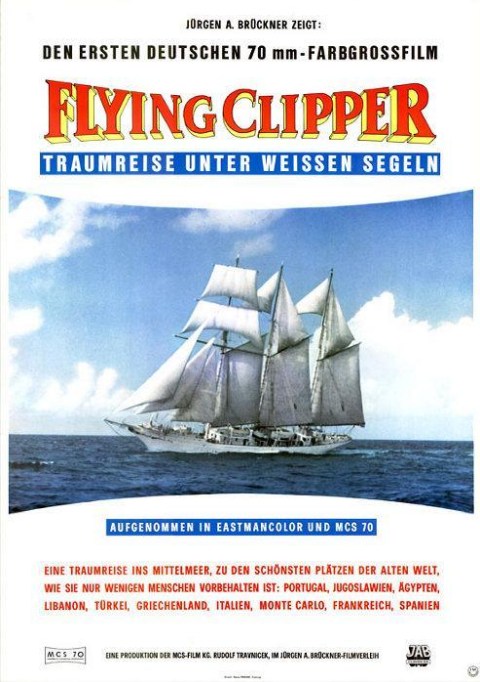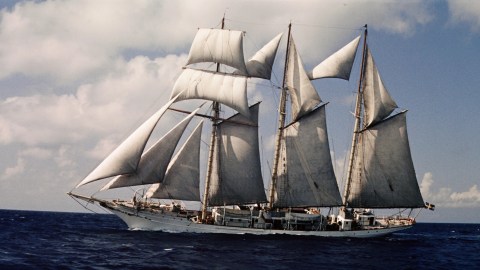17. 4. – 19. 4. 2026
Flying Clipper

 Original title: Flying Clipper - Traumreise unter weissen Segeln
Original title: Flying Clipper - Traumreise unter weissen SegelnDirector: Hermann Leitner & Rudolf Nussgruber
Production: 1962, West Germany
Length: 158 min.
Screened:
70mm film seminar 2007: 70mm 2.2:1, Colours faded, MG, Spoken language: Slovak, Subtitles: NoneKRRR! 2012: 70mm 2.2:1, Colours intact, DTS, Spoken language: German, Subtitles: Czech
Annotation for KRRR! 2012
The voyage of the beautiful three-masted ship across the Mediterranean Sea, captured in the West German documentary Flying Clipper – Under White Sails (1962), was an unforgettable experience for many cinemagoers in the 1960s and 1970s. Along with Cleopatra (1963) and The Battle of the Bulge (1965), the film was one of the international hits of its time. This is its second screening at the Krnov Festival.
Flying Clipper premiered in Munich in December 1962 and is often referred to as the first German film in the 70mm format. It was shot on brand new German MCS70 cameras, which differed from the American Todd-AO in that they were easier to operate in the field due to their lower weight. It was this flexibility of movement that was reflected in the film. The same camera was later used to film, for example, Black Tulip (1964) with Alain Delon and Old Shatterhand (1964) with Lex Barker.
For many eyewitnesses, Flying Clipper – Traumreise unter weissen Segeln, as its original title was, will automatically evoke memories of the high masts that sailors climbed, and also of the huge American aircraft carrier on which a Clipper sailor who develops acute appendicitis is taken away by helicopter. Verticals, horizontals… everything fit on the screen. The authenticity of the experience was further enhanced by one of the first uses of surround sound.
But it wasn’t just about the sea and the ships. From time to time, Captain Skoglund would give some of the twenty Swedish and German cadets time off and let them disembark, see the sights in and around the port cities, dance with local beauties or ride along steep mountain serpentines. In 158 minutes, you can see almost every tourist attraction in the Mediterranean. Thanks to a magnificent cruise, we get to know Portugal, Yugoslavia, Lebanon, Turkey, Greece, Italy and Spain. Finally, there is a meeting of the sailors with Prince Rainier and Princess Grace Kelly in Monaco…
Directors Herman Leitner and Rudolf Nussgruber used the help of the famous Austrian filmmaker Karl Hartl before filming, who collaborated on the concept and appearance of the film. Their idea largely coincided with another film, Windjammer (1958), where a three-masted ship with young Norwegian cadets instead of the Mediterranean Sea was racing across the Atlantic and the Caribbean. They even wanted to call their film Windjammer 2. In the end, the producers from M.C.S. – Film K.G. lost the dispute with the British company Cinemiracle International Pictures and had to rename the film.
But this did not affect the success of The Flying Clipper, which was shown in the States as Mediterranean Holiday, for several years. People were fascinated not only by the image, sound and new technology, but also by the music by Rizo Ortolani (later known for his soundtracks to German and Italian westerns, who also received two Oscar nominations) and the songs sung by his wife Katina Ranieri, whom they already knew from the musical motifs in Fellini films.
One of the shortcomings may be its overloaded plot, in which the filmmakers wanted to show that they had been everywhere, met everyone and experienced everything. These aspects, together with the commentary, which not everyone will find funny, are fortunately easily suppressed thanks to the captivating visual beauty of the film.